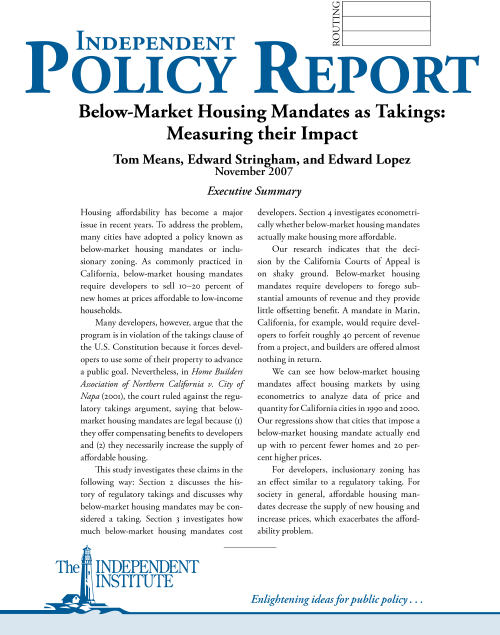Housing affordability has become a major issue in recent years. To address the problem, many cities have adopted a policy known as below-market housing mandates or inclusionary zoning. As commonly practiced in California, below-market housing mandates require developers to sell 10–20 percent of new homes at prices affordable to low-income households.
Many developers, however, argue that the program is in violation of the takings clause of the U.S. Constitution because it forces developers to use some of their property to advance a public goal. Nevertheless, in Home Builders Association of Northern California v. City of Napa (2001), the court ruled against the regulatory takings argument, saying that belowmarket housing mandates are legal because (1) they offer compensating benefits to developers and (2) they necessarily increase the supply of affordable housing.
This study investigates these claims in the following way: Section 2 discusses the history of regulatory takings and discusses why below-market housing mandates may be considered a taking. Section 3 investigates how much below-market housing mandates cost developers. Section 4 investigates econometrically whether below-market housing mandates actually make housing more affordable.
Our research indicates that the decision by the California Courts of Appeal is on shaky ground. Below-market housing mandates require developers to forgo substantial amounts of revenue and they provide little offsetting benefit. A mandate in Marin, California, for example, would require developers to forfeit roughly 40 percent of revenue from a project, and builders are offered almost nothing in return.
We can see how below-market housing mandates affect housing markets by using econometrics to analyze data of price and quantity for California cities in 1990 and 2000. Our regressions show that cities that impose a below-market housing mandate actually end up with 10 percent fewer homes and 20 percent higher prices.
For developers, inclusionary zoning has an effect similar to a regulatory taking. For society in general, affordable housing mandates decrease the supply of new housing and increase prices, which exacerbates the affordability problem.












